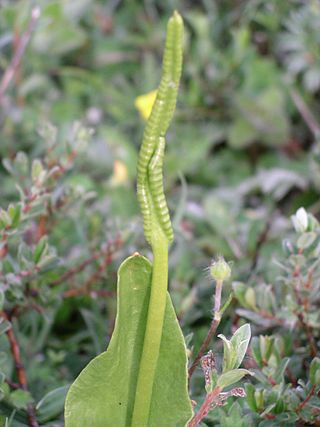
Ophioglossaceae, the adder's-tongue family, is a small family of ferns. In the Pteridophyte Phylogeny Group classification of 2016, it is the only family in the order Ophioglossales, which together with the Psilotales is placed in the subclass Ophioglossidae. The Ophioglossidae are one of the groups traditionally known as eusporangiate ferns. Members of the family differ from other ferns in a number of ways. Many have only a single fleshy leaf at a time. Their gametophytes are subterranean and rely on fungi for energy.
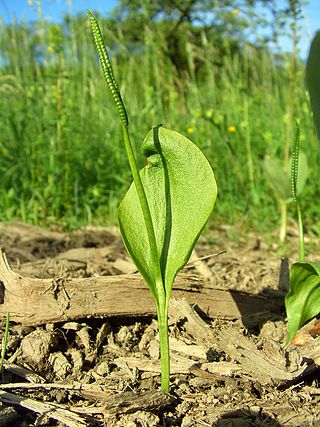
Ophioglossum vulgatum, commonly known as adder's-tongue, southern adder's-tongue or adder's-tongue fern, is a species of fern in the family Ophioglossaceae.

Salvinia, a genus in the family Salviniaceae, is a floating fern named in honor of Anton Maria Salvini, a 17th-century Italian scientist. Watermoss is a common name for Salvinia. The genus was published in 1754 by Jean-François Séguier, in his description of the plants found round Verona, Plantae Veronenses Twelve species are recognized, at least three of which are believed to be hybrids, in part because their sporangia are found to be empty.

Dicksonia is a genus of tree ferns in the order Cyatheales. It is regarded as related to Cyathea, but is considered to retain more primitive traits, dating back at least to the Jurassic and Cretaceous periods. The fossil record includes stems, pinnules, and spores.

The genus Ophioderma are distinctive ferns in the family Ophioglossaceae. Ophioderma is closely related to, and sometimes treated as a subgenus of, the genus Ophioglossum. It includes the genus formerly known as Cheiroglossa. Recent genetic analysis has indicated that the two genera should be treated as one, and Ophioderma has precedence by being validly published at an earlier date. The type species is Ophioderma pendulum.

Ophioglossum azoricum, the small adder's-tongue fern or lesser adder's-tongue fern, is a small fern of the family Ophioglossaceae.

The Athyriaceae are a family of terrestrial ferns in the order Polypodiales. In the Pteridophyte Phylogeny Group classification of 2016 (PPG I), the family is placed in the suborder Aspleniineae, and includes two genera. Alternatively, it may be treated as the subfamily Athyrioideae of a very broadly defined family Aspleniaceae. The family has with a cosmopolitan distribution.
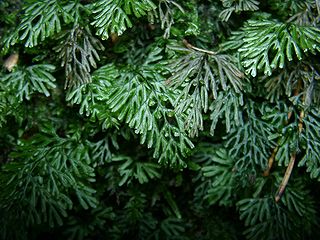
The Hymenophyllaceae, the filmy ferns and bristle ferns, are a family of two to nine genera and about 650 known species of ferns, with a subcosmopolitan distribution, but generally restricted to very damp places or to locations where they are wetted by spray from waterfalls or springs. Fossil evidence shows that ferns of the family Hymenophyllaceae have existed since at least the Upper Triassic.
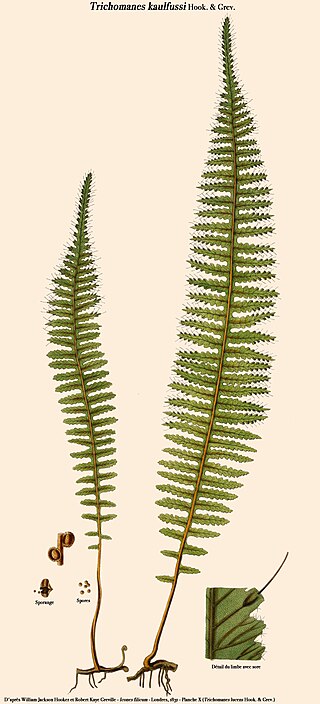
Trichomanes is a genus of ferns in the family Hymenophyllaceae, termed bristle ferns. The circumscription of the genus is disputed. All ferns in the genus are filmy ferns, with leaf tissue typically 2 cells thick. This thinness generally necessitates a permanently humid habitat, and makes the fronds somewhat translucent. Because of this membrane-like frond tissue, the plant is prone to drying out. “Filmy ferns” in the taxa Hymenophyllaceae grow in constantly wet environments. Many are found in cloud forests such as “Choco” in Colombia. There are also members of the taxa that can grow submersed in water.

The fern flower is a magic flower in Baltic mythology, in Estonian mythology and in Slavic mythology.
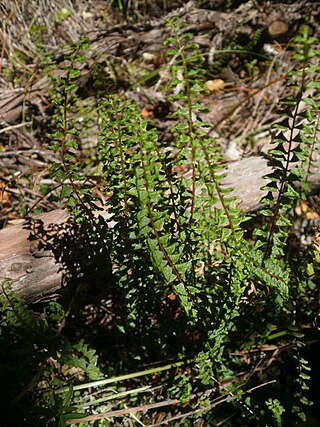
Lindsaeaceae is a pantropical family of ferns in the order Polypodiales. It contains six or seven genera with about 220 known species, some of which also extend into the more temperate regions of eastern Asia, New Zealand, and South America.

Antrophyum is a genus of ferns in the family Pteridaceae. They are commonly known as lineleaf ferns.
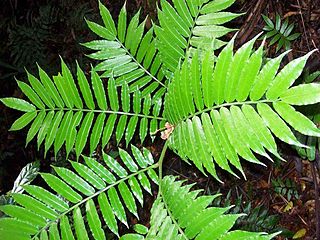
Angiopteris is a genus of huge evergreen ferns from the family Marattiaceae, found throughout the paleotropics from Madagascar to the South Pacific islands. Species of smaller stature with elongate synangia and creeping rhizomes are sometimes segregated into the genus Archangiopteris, and a once-pinnate monotypic segregate genus has been called Macroglossum, but molecular data supports inclusion of these taxa within a broad concept of Angiopteris.
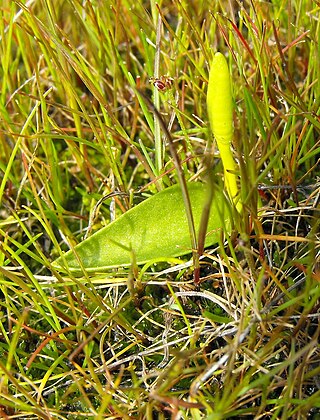
Ophioglossum californicum, known by the common name California adder's tongue, is an uncommon species of fern in the family Ophioglossaceae.
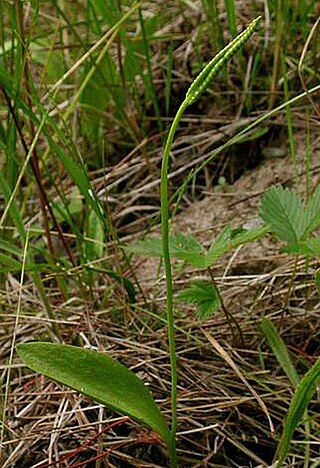
Ophioglossum pusillum is a species of fern in the family Ophioglossaceae known by the common name northern adder's tongue.
Cheiroglossa palmata, synonyms Ophioderma palmatum and Ophioglossum palmatum, variously known as hand fern, dwarf staghorn, or hand tongue, is an epiphytic or terrestrial fern. As an epiphyte it grows in old leaf bases of the cabbage palmetto.
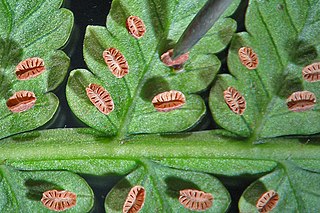
Eupodium is a genus of ferns in the family Marattiaceae native to the Neotropics. Traditionally, many taxonomists have included Eupodium within the genus Marattia. However, molecular phylogenetic studies and morphological studies of extant and fossil taxa support the recognition of Eupodium as a lineage distinct from Marattia. Morphologically, Eupodium was thought to be distinct among the Marattiaceae in only having one frond at a time, bearing awns along veins, and having stalked synangia. However, recent phylogenetic work found that an additional species native to Brazil, Eupodium cicutifolium, which lacks these characters, is also genetically in Eupodium, making the genus challenging to distinguish morphologically. Eupodium cicutifolium does occasionally have short-stalked synangia, and has spinulose spores like the other Eupodium species, but is otherwise easily mistaken for a Marattia or Ptisana. The genus currently has four recognized species.

Marattia is a small genus of primitive, large, fleshy eusporangiate ferns. It is the type genus of the family Marattiaceae, order Marattiales and class Marattiopsida. Formerly considered to be a much larger genus, genetic analysis has shown that Marattia in the broad sense was paraphyletic, and subsequently the genera Ptisana and Eupodium were split off. Except for one species in Hawaii, the genus is neotropical.

Ophioderma pendulum is sometimes known as the old-world adder's-tongue. In Malaysia, it is known as daun rambu. It is a fern in the family Ophioglossaceae, and is the type species of the genus Ophioderma. It is most noteworthy for the length of its pendant fronds, up to 14 ft 9 in in length and three inches (8 cm) wide produced at intervals along a tree-clinging rhizome.

















